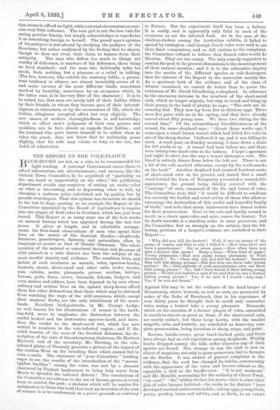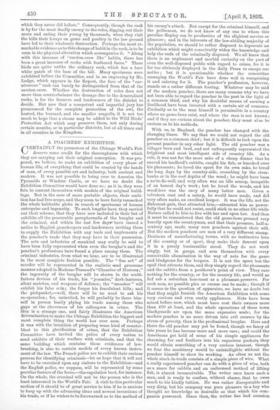THE REPORT ON THE VOLE-PLAGUE. B LUE-BOOKS are not, as a
rule, to be recommended for light reading. A paternal Government issues them to afford information, not entertainment ; and anxious, like the Oxford Town Councillor, to be acquitted of "partiality on the one hand or impartiality on the other," the publishing department avoids any suspicion of setting an undue value on what is interesting, and so depressing what is dull, by charging a uniform price, calculated not by quality, but by pounds avoirdupois. That this system has its merits we should be the last to deny, quoting as an example the Report of the Committee appointed by the Board of Agriculture to inquire into the plague of field-voles in Scotland, which has just been issued. This Report is in many ways one of the best works on natural history which has appeared during the last few years. It gives at length, and in admirable arrange- ment, the first-hand observations of men who spend their lives on the moors of the Scottish Border,—shepherds, foresters, gamekeepers, farmers, and naturalists, often in language as quaint as that of Dandle Dinmont. The whole question of the natural or unnatural increase and decrease of wild animals in a wide district has been the subject of the most careful inquiry and evidence. The numbers, lives, and habits of such creatures as weasels, voles, sparrow-hawks, kestrels, stoats, short-eared and other owls, rooks, ravens, rats, rabbits, moles, pheasants, grouse, merlins, hobbys, herons, gulls, foxes, crows, buzzards, falcons, badgers, and even snakes and adders, have been deposed to by men whose solitary and serious lives on the upland sheep-farms afford them few other distractions than those which may be obtained from watching the ways of the wild creatures, which, except their masters' flocks, are the only inhabitants of the moor- lands. Excellent bird-portraits, by Mr. George Lodge, so well known for his illustrations of scenes in the hawk- ing-field, serve to emphasise the distinction between the useful kestrel and the destructive sparrow-hawk, and intro- duce the reader to the short-eared owl, which has now settled in numbers in the vole-infested region ; and if the mind wearies of the woes of the Scottish dalesmen, the de- scription of the visit of the enterprising chairman, Sir Herbert Maxwell, and of the secretary, Mr. Harting, to the vole- infested plains of Thessaly, presents a picture of the impact of the restless West on the brooding East which cannot fail to raise a smile. The chairman of "your Committee " landing, eager to see the results of the introduction of the " mouse- typhus bacillus" among the voles, was met by a steamer chartered by Turkish landowners to bring holy water from Mecca to sprinkle the infected district ! The conclusions of the Committee are adverse to the use of disease-germs in every form to combat the pest; a decision which will be matter for satisfaction to those who hold that such an inversion of the uses of science is to be condemned on a priori grounds as contrary to Nature. But the experiment itself has been a failure. It is costly, and is apparently only fatal to such of the creatures as eat the infected food. As in the case of the chicken-cholera among the Australian rabbits, it failed to spread by contagion; and though Greek voles were said to eat their dead companions, and so fall victims to the complaint, the Committee refused to believe that Scotch voles would do likewise. They are too canny. The only remedy suggested to combat the pest in its present dimensions is the encouragement of their natural enemies; and it is in the exhaustive inquiry into the merits of the different species as vole-destroyers, that the interest of the Report to the naturalist mainly lies. As a specimen both of the evidence and of the class of witness examined, we cannot do better than to quote the testimony of Mr. David Glendining, a shepherd. In reference to the enormous increase in the numbers of the short-eared owls, which no longer migrate, but stay to breed and bring up their young in the land of plenty, he says " The owls are in- creasing fast. They now lay from five to thirteen eggs. There were five pairs with me in the spring, and they have already reared about fifty young ones. We have two sitting for the second time." Of the extraordinary bloodthirstiness of the weasel, the same shepherd says : "About three weeks ago, I came upon a small brown weasel which had killed five voles in one of the sheep-drains. I followed it up, and it was killing its sixth. A week past, on Sunday morning, I came down a drain for 250 yards or so. A weasel had been before me, and there were twenty-two dead voles in the bottom. I kept a specimen last night to show you the way a weasel destroys a vole. The blood is entirely drawn from below the left ear. There is not a bit of the vole marked otherwise, except by the teeth-marks on the head." Another shepherd had counted fourteen nests of short-eared owls on his ground, and stated that a small wood behind the farm of Howparley presented a remarkable appearance, the ground being thickly covered with the " castings " of owls, composed of the fur and bones of voles. The Committee state that " it would be difficult to condemn too severely the foolish and cruel action of those who allow or encourage the destruction of this useful and beautiful family of birds," and note that many landowners have issued orders for their preservation. Next to the owl, and hardly second in merit, as a check upon voles and mice, comes the kestrel. Yet its death-warrant is a standing order in most preserves, and the Committee feel so strongly on the subject, that the fol- lowing portions of a keeper's evidence are embodied in their Report:— "Why did you kill the kestrel ? Well, it was an enemy of the game, of course, and that is why I killed it.—How long have you been a gamekeeper ? Six or seven years.—How often have you seen a kestrel take game P Many a time.—What kind of game ? Young pheasants.—Had you many young pheasants at West Bucoleuch P No.—Then why did you kill the kestrel P Because they will kill riling grouse.—Did you ever see them take young grouse P No.—Did anybody of your acquaintance ever see them take young grouse P No ; but I have heard of their taking young grouse.—Would you believe a man if he said that he saw a kestrel taking young grouse ? Yes, if he said it I would.—Any man P Yes, if he was not drunk."
Against this may be set the evidence of the head-keeper at Drumlanrig, where kestrels, as well as owls, are preserved by order of the Duke of Buccleuch, that in his experience of over thirty years he thought that he could only remember twice seeing a kestrel take a young pheasant. Buzzards, which on the occasion of a former plague of voles, assembled in numbers almost as great as those of the short-eared owls, are nearly extinct; but these large hawks, with the smaller seagulls, owls, and kestrels, are scheduled as deserving com- plete preservation, being harmless to sheep, crops, and game.
Ravens, hoodie-crows, great black-backed gulls, and foxes have always had an evil reputation among shepherds. Weakly lambs dropped among the hills suffer wherever any of their species are found. But, strange to say, the rook is now an object of suspicion, not only to game preservers, but to farmers on the Border. It was matter of general complaint in the evidence, that the rook has changed its habits, concurrently with the appearance of the voles, and become almost as dis- reputable a bird as the hoodie-crow. "It is not madness," said Mr. Bumble, accounting for the audacity of Oliver Twist, " its meat." " So," within the last ten years—that is since their dish of voles became habitual—the rooks in the district " have developed marked carnivorous habits; taking eggs, young birds, young poultry, hares and rabbits, and so forth, to an extent which they never did before." Consequently, though the rook is by far the most deadly enemy to the voles, digging out their nests and eating their young by thousands, when they visit the hills their forays on game and poultry in the low ground have led to their wholesale destruction. Perhaps the most re- markable evidence as to this change of habit in the rook, is to be seen in the physical alteration which accompanies it. " Along with this increase of carrion-crow like' habits, there has been a great increase of rooks with feathered faces." These birds are quite unlike the ordinary rook, which has a bare white patch at the base of the bill. Many specimens were exhibited before the Committee, and in an engraving by Mr, Lodge, which appears in the Report, the face of the " car- nivorous " rook can barely be distinguished from that of the carrion-crow. Whether the destruction of voles does not more than counterbalance the damage due to the demoralised rooks, is for the farmers and landowners of the district to decide. But now that a competent and impartial jury has pronounced for the complete protection of the owl, the kestrel, the buzzard, and the smaller seagulls, it is not too much to hope that a clause may be added to the Wild Birds' Protection Act which may preserve them, not only during certain months, or in particular districts, but at all times and in all counties in the Kingdom.



































 Previous page
Previous page